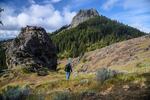
The Cascade-Siskiyou National Monument in Oregon.
Bob Wick/BLM
Washington Attorney General Bob Ferguson is pledging to defend the state's national monuments. Ferguson sent a letter to U.S. Secretary of the Interior Ryan Zinke defending the Hanford Reach National Monument, which is up for review under an executive order.
Ferguson asserts that President Trump and Zinke don't have the legal authority to revoke national monuments. The review could wind up shrinking, modifying or eliminating some monuments altogether.
"If the President seeks to do harm to Washington's National Monuments by eliminating or reducing them, my office will initiate litigation to defend them," Ferguson wrote.
Three monuments are up for review in the Northwest: Hanford Reach, the Cascade-Siskiyou National Monument in Oregon, and Craters of the Moon National Monument and Preserve in Idaho.
The list includes 22 national monuments mostly in the West and five marine national monuments. The Antiquities Act of 1906 gives presidents the authority to protect lands deemed important for cultural or natural resources, without congressional approval or consultation of local residents.
"No President, however, has ever claimed the authority to revoke National Monument status," Ferguson's letter states. "The reason is simple: the Act does not contemplate any such revocation, and to do so would be contrary to the language of the statute and the structure in which the law delegates Congress's constitutional authority. It also would contravene later congressional action."
In his letter, Ferguson also states that he worries the language of the executive order could leave other monuments open to review, including the San Juan Islands National Monument.
Ferguson's letter comes a day after U.S. Sens. Maria Cantwell and Patty Murray sent a letter of their own to Zinke, opposing the review of Hanford Reach.
"Rolling back protections for some of our nation's most prized public spaces, like the Hanford Reach National Monument, does not exemplify President Roosevelt," the senators wrote.
The Hanford Reach National Monument, which is about 194,451 acres, was created in 2000 and is home to a variety of wildlife and some rare plants. The area also includes the longest free-flowing freshwater portion of the Columbia River, where fall chinook spawn. It's also an important cultural area for the Yakama Nation. The B-Reactor, just outside the national monument area, was recently designated a part of the Manhattan Project National Historical Park.
The Cascade-Siskiyou National Monument was established in 2000 and expanded by President Obama in 2017, from 65,000 acres to 113,000 acres. It's the first national monument set aside with the only purpose of preserving biodiversity.
Craters of the Moon National Monument and Preserve, a largest exposed lava flow with a scattering of cinder cones and sagebrush islands, was established in 1924 and greatly expanded by President Clinton in 2000 to about 14 times its original size. The monument is now more than 700,000 acres.
The public can submit online comments about the review after May 12, for a 60-day period. Written comments can be sent to: Monument Review, MS-1530, U.S. Department of the Interior, 1849 C Street NW, Washington, DC 20240.

